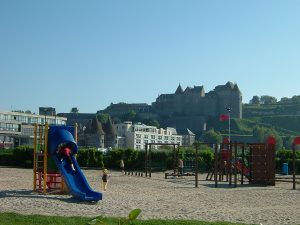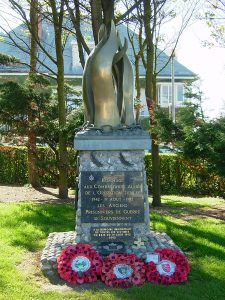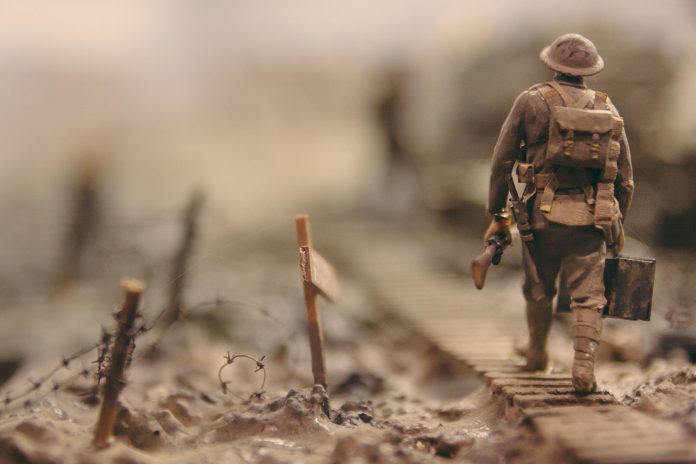How could it be this easy, this return to that port, its name “Dieppe” now seared infamously into Canada’s national memory for the past two years and thirteen days? There, on 19 August 1942, 6000 soldiers, 5000 of them Canadian, attempted the first Allied landing against Hitler’s “Fortress Europe”. His most renown general, Erwin Rommel, had since been further fortifying German defences along the English Channel of occupied France. From England across this narrow passage an inevitable amphibious invasion would certainly be launched. Was Hitler’s “Atlantic Wall” impregnable, as Nazi propaganda vaunted, certain this would reach the ears of Allies planners in England? The horrendous casualties of the nine Canadian and two British commando regiments of the Dieppe Raid reinforced that boast, reviving the term “cannon fodder”, referring to Canadians the seemingly callous way British commanders deployed their troops in the trench warfare of 1914-1918.
Of the soldiers of the 2nd Division, Canadian Army nearing Dieppe in late August 1944, very few were returning. All nine regiments landing two years and thirteen days ago had then been decimated; for example, 502 of the 553 members of the “Essex Scottish” were casualties left on the beach. Each regiment had to painstakingly rebuild, as each had merely 25 or so survivors for this return engagement. As all of our fighting men were volunteers to this point, Dieppe hardly spurred enlistment. None of the nine had regained sufficient strength to land on Juno Beach by D-Day, 6 June, 1944, the epical event that occurred three months prior to their return.
D-Day succeeded with far fewer casualties than its planners anticipated, in large part, said Allied commanders, due to bloody lessons learned at Dieppe. Cold comfort to Canadian soldiers but regardless of their scepticism, the nine regiments were as determined to return to Dieppe as they had been eager to undertake the raid. To that end, after the Battle of Normandy the task assigned to the Canadian Army was to seize key ports along the Channel to allow for easier massive transfers of manpower and matériel essential for the Allied advance to Berlin.

An aerial bombardment with offshore shelling from battleships was planned for early September 1st to soften German defenses at Dieppe prior to the 2nd Division’s entry, this time by land two years and thirteen days after the raid. These preliminaries were eerily similar to the plans that provided utterly inadequate support for the landings two years and thirteen days ago. Now, in a cruel twist of irony, they were unnecessary.
After overcoming heavy resistance during its inexorable slog along the Channel, the 2nd Division’s last 70 km to Dieppe seemed a romp. It met only sporadic sniping as the German army, the Fuhrer’s once-invincible Wehrmacht, accepting the inevitable, hastily withdrew to defend Germany’s Rhine frontier. Thus the taking of Dieppe was almost a formality, yet nonetheless highly symbolic and a tonic to a war-weary nation and much more so for the nine regiments seeking some atonement for the carnage wrecked upon them two years and thirteen days ago. It also offered welcome deliverance to the beleaguered citizens of occupied Dieppe.
A halt was ordered outside city limits the eve of August 31. When the 2nd Division, Canadian Army entered next morning at 10:30, it was as spiffy for a “spit-and-polish” parade as field conditions permitted – cold-water shaves, shined boots, freshly-pressed uniforms from the quartermaster. The tumultuous greeting this time was purely vocal, from overjoyed citizens several ranks deep lining the parade route where two years and thirteen days ago they crouched in cellars, puzzled as to what had unleashed that hellish artillery fire pouring from their cliffs, unaware that Canadians were attempting a futile landing on their beach. First to enter Dieppe, buildings still pockmarked by bullets fired two years and thirteen days ago, were the regiments from 19 August 1942. To reporter Ross Monroe, accompanying the 2nd Division, this was “the most impressive and meaningful Canadian parade of the war.”

The initial orderliness eventually disintegrated, not from withering enemy fire but from effusive, long-repressed citizenry pressing forward offering flowers, wine and embraces. Parade marshals, likely aware of casualties in battles to come, allowed their “lads” to be swept away by the crowd. None paid café bills this day; many were treated to home-cooked meals in spite of the privations of rationing imposed by the occupiers. (One man I met at the Square du Canada, Dieppe, in 2004 said the raid was his earliest childhood memory. He had a jaundiced, albeit humorous, opinion of his Canadian liberators, in sharp contrast to that of his fellow Dieppois. Email me – hogtownlarry19@gmail.com – for his story of his life between the raid and the day of liberation.)
In spite of entreaties to celebrate, for the 25 or so from each regiment who landed here two years and thirteen days ago there was a greater necessity. However painful, they steeled themselves to revisit that beach where on its shingle man and vehicle floundered with fatal consequences. Formidable concrete defences of two years and thirteen days ago had been strengthened further; the esplanade now fully barbed wired, the beach now thoroughly mined. Then, led by locals, also non-festive, they reached a plot smothered with so many fresh flowers that the plain nameless wooden crosses were hard to discern. Local people situated this cemetery to overlook the beach. Without being ordered by the Germans they removed over 900 dead raiders, burying them here where they dutifully maintained this ground. They were ordered not to put flowers on graves nor erect any memento to the slain. Plans of the plot were kept clandestinely, with each deceased ID recorded to match each cross location, so that his name could be properly inscribed on his cross after the Occupation. A strengthening onshore wind now chilled the exposed hilltop cemetery.
They could hear comrades and other Dieppois beckoning them to join festivities in the town centre. Memories of two years and thirteen days ago would never be erased, but they would attempt to set them aside for a short bout of merrymaking. They had earned it.
Mathew Halton’s broadcast of the Canadians’ entry into Dieppe can be heard online at: archives.cbc.ca/war_conflict/second_world_war/…/13810/. Handkerchiefs recommended.
Much material for this article is to be found in “The Canadians at War: 1939-1945”, Reader’s Digest Association and “Gauntlet to Overlord” by Ross Monroe.
The nine Canadian regiments landing at the Dieppe raid were:
Royal Regiment of Canada, Essex Scottish Regiment, Les Fusiliers de Mont-Royal, Black Watch (Royal Highland Regiment), 14th Army Tank Regiment (The Calgary Tank Regiment), South Saskatchewan Regiment, Toronto Scottish Regiment, Royal Hamilton Light Infantry and Queen’s Own Cameron Highlanders of Canada.
The British units were No. 3 Commando and No. 4 Commando, Royal Marines.
There were 50 U.S. Rangers, in a largely observatory capacity.
The author is a retired secondary school teacher living in Toronto. He can be reached at hogtownlarry19@gmail.com and you can receive a copy of “A Dieppe Boy’s War”, published in 2004 by Esprit du Corps and Our Canada magazines.
Image Credit


























